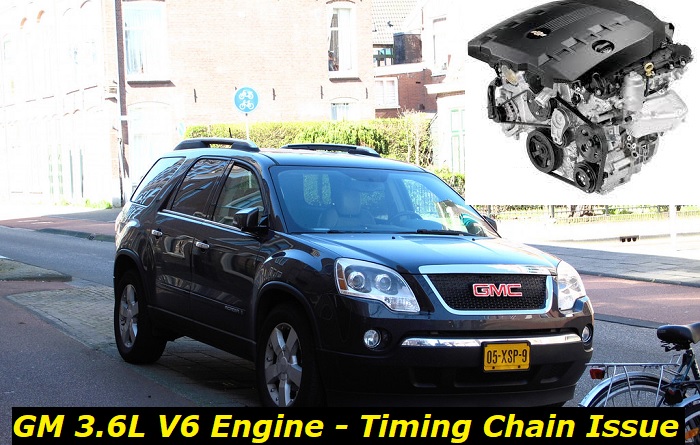The GM 3.6L engine is a widely used V6 engine in many American-made SUVs, trucks, and cars. In fact, since its debut in 2004 in Cadillac CTS, this is the most popular 3.6L engine from General Motors to date.
Key features and my opinion about the engine
- Production years:2007-2017
- Average lifespan of LLT:180,000-210,000 miles
- Fuel supply type:direct injection
- Power range:280-315 hp
- Fuel efficiency:bad
- Engine block material:aluminum
- Engine reliability score:medium
- The most common problems:weak timing chain, complicated injection system, carbon buildup on intake valves, water pump problems.

General Look at the 3.6L GM Engine
The GM 3.6L is a powerful engine that has undergone several upgrades over the years. These upgrades have been undertaken to improve the engine's performance and correct some existing faults in the previous models.
Like many car engines, the GM 3.6L V6 engine has been dogged by some issues. The timing chain problems have been persistent and have been a headache for many car owners. If so many online car forums where car owners share ideas and ultimately get help through them, then the GM 3.6L engine timing chain problem is not something that one can wish away just yet.
The GM 3.6L engine boasts many benefits and, in some instances, is considered a V8 comparable in terms of power and performance. Indeed, many cars such as the Hummer 2, Chevrolet Camaro, and GMC Acadia use the GM engine.
The GM 3.6L engine comes with its share of issues, but in this article, we will take an in-depth look into the timing belt/chain problems that have dogged this engine for a long time.
Understanding the timing chain
The timing chain plays a vital role in internal combustion, ensuring the engine's proper running. The chain harmonizes the crankshaft and the camshaft rotation, and then the pistons and the valves will operate at optimal capacity.
But the camshaft and the crankshaft must be synced perfectly for this to be achieved. The timing chain has to run smoothly and without skipping any teeth. A properly working timing chain ensures the right amount of fuel, air, and exhaust gas are mixed before the piston is pushed down.
Though the chain is made of metal, it wears out. We will explore the problems associated with the GM 3.6L timing chain, which tends to wear out way too soon than those installed in many other cars.
The timing chain problems
While the timing chain issue is commonly associated with the GM 3.6L engine, it is more common in the LY7 version. The LY7 GM 3.6L engine was introduced in 2004 and has a 10.2:1 compression ratio. The engine is still in production to date.
The earlier versions of the LLT engine are also prone to this problem. Following numerous timing chain problems, GM upgraded the engines to address the issue. Cars using the GM 3.6L engine made in 2012 and onwards have fewer timing chain issues.
- Overconsumption of oil
Vehicles using the GM 3.6L are known to consume more than average when it comes to oil. Drivers must frequently replenish the oil to prevent the engine from depleting the oil, hence putting a strain on the timing chain tensioners.
If there is slack in the timing chain, then some teeth will be skipped, leading to the chain overstretching. Repairing this anomaly requires a lot of money.
There is a need to be vigilant to catch the running low oil problem in time. Several drivers have reported that the engine can run out of oil before the car even alerts the driver on the dashboard.
Many drivers have resulted in servicing their vehicles at 5000 miles or less. One needs to check the oil level frequently and also carry at least a quart of oil in the trunk just in case.
- Timing chain stretching
The camshaft and the crankshaft have a close correlation. If the timing chain stretches, this correction is affected. This causes the valves to open and close at the wrong time. The Engine Control Module (ECM), which closely monitors everything about the engine, will pick this anomaly in the valve opening and closing and trigger the CEL light.
This will probably be followed by the engine misfiring and, in extreme cases, stretching the chain so the engine won't start.
What causes timing chain problems in the GM 3.6L engine?
The GM 3.6L V6 engine is generally robust and a great performer. However, the timing chain issue is widely known such that when you ask in the online forums what to do with your faulty engine, a good number of people will advise you to just repair the car and sell it.
To understand the timing chain issue in this engine, we need to establish what causes it:
- Inadequate lubrication. The GM 3.6L engine is quite thirsty, and as such, it requires more oil than most V6 engines. Draining such oil should be done a lot more frequently too. Infrequent and inadequate oil in the engine means the engine runs on degraded oil. This means the whole system is inadequately lubricated, which then causes more than usual wearing out of parts. When this problem persists, the timing chain stretches in length and can even fail in some cases.
- There is a design fault that can be blamed on GM. General Motors changed the chain's design to a 7.7mm pitch from 9.5mm. In 2012, GM issued a memo where they offered a 'special adjustment timing chain wear' for cars running on the 3.6L engine. They went further to extend the timing chain warranty to 120,000 Miles, or 10 years whichever comes first.
- General Motors installed an Oil Life Monitor (OLM) in the earlier models of the 3.6L engine and calibrated it to allow for excessive mileage between oil changes. The company changed the mapping of the OLM to a shorter sequence. The problem seemed to drastically reduce in the newer models that were not using the OLM.
How do you know your car needs a new timing chain?
Because the GM 3.6L has been known to have timing chain issues, many drivers are on the lookout for any symptoms that indicate their car might have that issue. Many of the symptoms are easy to spot, but there are those that a mechanic can only identify. So, it is essential to ask your mechanic to help you pick some of the symptoms.
Here are the signs to look out for:
- Engine misfiring or runs poorly
- Metal shavings can be found in the oil
- The engine won't start, or it will just fail
- There is a ticking noise in the engine
- You'll notice more smoke and fumes than normal
- Check Engine Light (CEL) is on
- The engine starts acting up when the RPM reaches between 2000 and 4000
- There will be an oil leak at the front of the motor
- Engine rattles while idling
How to fix the GM 3.6L V6 engine timing chain issue
The timing chain issue has been persistent in the GM 3.6L engine. General Motors has repeatedly come forward to solve this issue but not to the satisfaction of all the customers. At one time, the company replaced the timing chain for free and, at other times, extended warranties on the engines.
In earlier days, GM even went in as far as making their oil spec called DexosI. Clearly, this never worked since the problem persisted.
Besides the company's numerous efforts to try and solve this issue, here are some of the things you can do to fix the problem:
- According to some drivers who have experience using the GM 3.6L engine, using oil with low NOACK helps keep the engine lubricated. Using a 5w-30 quality type of oil and changing every 5000 miles is said to help keep your timing chain intact.
- If the car shows the symptoms indicated earlier in the article, which include engine backfiring, CEL going on, and a ticking sound coming from the side of the engine, it is time to visit a mechanic. Check GM bullet in No 11340B released on 29th June 2012, which extended the engine's warranty to 10 years or 120,000 miles. The models covered were 2007-2009. The dealers will replace the timing chain, and all the repairs will be done for free.
- In some instances where the warranty has lapsed, you will need to gauge whether replacing the timing chain is practical or not. Replacing a timing chain in a GM 3.6L engine will cost you between $2000 and $ 3000. Buying a new engine will cost you around $7,000 or more. Given the risk of reoccurring timing chain problems, some car owners who have replaced the chain have sold their cars soon after. This raises a unique concern: many cars that run on this engine will be sold just before their warranties expire. This means new owners who buy these cars, many of whom without an idea of the problems dogging the vehicles will be in for a rude shock after only using the cars for a short time. General Motors should come up with a good solution to the timing chain issue because, much as the engine remains generally popular, the brand name can be tarnished by the bad PR the GM 3.6L gets.
About the authors
The CarAraC research team is composed of seasoned auto mechanics and automotive industry professionals, including individuals with advanced degrees and certifications in their field. Our team members boast prestigious credentials, reflecting their extensive knowledge and skills. These qualifications include: IMI: Institute of the Motor Industry, ASE-Certified Master Automobile Technicians; Coventry University, Graduate of MA in Automotive Journalism; Politecnico di Torino, Italy, MS Automotive Engineering; Ss. Cyril and Methodius University in Skopje, Mechanical University in Skopje; TOC Automotive College; DHA Suffa University, Department of Mechanical Engineering






Add comment